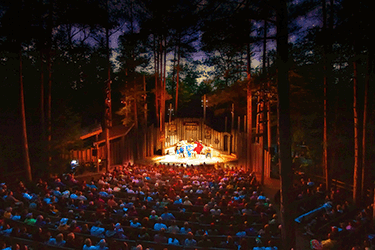Nestled into a hillside of Fish Creek, Wisconsin’s Peninsula State Park – some 65 miles north of Green Bay – lies the American Folklore Theatre (AFT), which is now home to a new DiGiCo SD9T mixing console supplied by Arrow AV Group of Appleton.
American Folklore Theatre
- Although far from the bright lights and big city, AFT is hardly a typical community theatre group. With eight performances a week from June to August, shows run concurrently and are all-original in both script and music. This is a “real” theatre company, so when the time came to upgrade the audio system, AFT’s production team chose to turn to a true theatre professional: DiGiCo.
- “We were using all of the inputs and all of the outputs on our old analog console and not coming close to meeting our needs,” said AFT sound designer David Alley. “I was looking for something to upgrade to that would satisfy both our current and future needs as well as keep our music supervisors, directors and artistic directors happy.”
- Alley notes that the expectations were high. One of the music supervisors, as an example, has a day gig doing music for all of the touring Billy Elliot shows in the United States and a significant Broadway background. Alley, who used numerous digital consoles while touring with AFT in other venues, says he knew he had to go digital and, for him, the moment of clarity was finding out that the team mixing the Grammys had switched to DiGiCo a couple of years ago. That was when he started looking at how to bring the appropriate DiGiCo solution to AFT.
- That ended up being the compact SD9T, which brings many of the high end, theatre-oriented features of the much larger SD7 – a fixture in theaters on both Broadway and London’s West End – to a smaller frame size and much more affordable package.
- The “T” part of the package ended up being the key to the system. On one of the recent shows called “Strings Attached,” Alley used 10 wireless performer mics, multiple stereo keys, drums, ukes, guitars and bass, plus MainStage for orchestral sounds and Figure 53’s QLab running additional music tracks, effects and a click track for the band. And the show file included more than 130 separate cues.
- “The ability to have real cues and not just snapshots—cues where I can control level and EQ and everything I can possibly need have made all the difference in the world.” Alley also specifically called out the 12 Control Groups (otherwise known as VCAs) on the SD9T as well as ability to change levels on all of them on a cue-by-cue basis.
- “One of the things that is not often discussed but has made a huge difference is being able to control monitors in the cues in addition to main level and EQ. Sometimes a performer will want more monitor for just one song, or perhaps just for the intro to a song. And being able to write that change into the cue makes everything go much more smoothly.”
- Another standout feature of the SD9T is the Performer function, which is a godsend for theatre companies in which multiple people may play the same role on different nights. It allows the engineer or programmer/designer to make EQ and level changes within individual cues by calling up a list of every cue that includes a specific performer.
- Mixing shows at AFT along with Alley is Nic Trapani, who Alley describes as “way younger than me and barely knows what analog is.” But age aside, Trapani has been programing for theatre productions for several years and has used a bevy of different digital boards. He describes the SD9T as “the most intuitive, easy to use and program console out there.” Again, he comes back to the T package and the cues. “On other systems, changing a cue or even just inserting a new cue into the stack was cumbersome. On the SD9T, from the first time I laid hands on it, I could change anything about any cue in far less time. And the SD9T has given us more consistent results, which allows us to really listen and adjust at a much finer level than we had before.”
- As many other engineers have noted, the sound quality of DiGiCo’s products means they use far less EQ than they are used to. “I was so excited to have all of the graphic EQs available. I always had performers where I had real issues and just not enough EQs to fix them all. The funny thing is that, with the SD9T, I am not using a single graphic EQ.”
- Trapani concurs noting that he uses a dynamic EQ on one performer in the show he mixes and “maybe I knock out a little 2K” on the other inputs, but that otherwise the system is remarkably flat.
- While the addition of the T software added substantially to the cost, Alley notes that in order to get the level of theater-specific features in any other platform meant looking at pricing that is roughly quadruple what the SD9T cost. “For the budget we had, there was just no better choice. The addition of the Theatre software allows us to do our jobs so much better than with any other system we have used. It is just unbelievable what the Theatre software allows us to do.”
- “Having a board of directors with vision has been crucial to this upgrade process,” said Alley. “I have had to do a lot of shows in theaters with 20-year-old consoles and crunchy old analog gear with cruddy pots. When we are doing shows at home, I never have to worry again about having what I need to do the show and music justice.”










